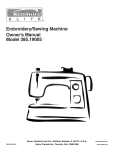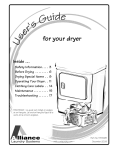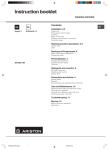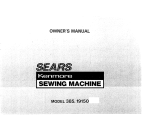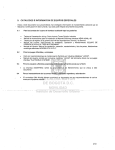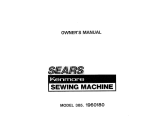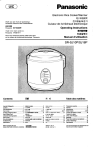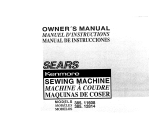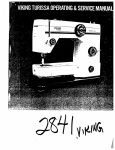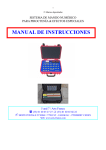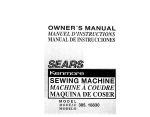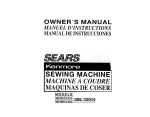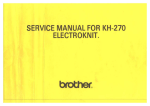Download Radio Shack 22-1697 Radar Detector User Manual
Transcript
OWNER'S
MANUAL
SEA/RS
SEWING
MODEL
MACHINE
3
4
SEARS, ROEBUCKANDCO.
Dear Customer:
You have just invested in a very fine z_gzag sewing machine. Before using your new Kenmore machine,
please pause for a moment and carefully read this booklet Which contains instructions on how to operate
and care for your machine.
Specific instructions are given on threading, tension adjustments, cleaning, oiling, etc. This will help you
obtain the best sewing results and avoid unnecessary service expense for conditions beyond our control.
Advice on the operation and care of your machine is always available at your nearest Sears Retail Store.
Please remember, if you have q,#estions about your machine or need parts and service, always mention
the model number and serial number when you inquire.
Kenmore
Sewing
Machine
Record in space provided below t he model number and serial
number of this appliance. The model number and serial number
are located on the nomenclature plate, as identified on Page 4 of
this booklet.
Model No. 385.
Seria{ No.
Retain these numbers lot future reference.
THIS MODEL IS A CENTER NEEDLE, LOW BAR SEWING MACHINE.
IMPORTANT SAFETY
INSTRUCTIONS
Your sewing machine is designed and constructed only for HOUSEHOLD
Read all instruction before using this sewing machine.
DANG E R--toredu ce the risk ot electric
1.
An appliance should never be left unattended
shock:
when pluggedin_
unplug this appliance from the electric outlet immediately
before cleaning.
2.
Always unplug before relampmg.
Watts.
3.
Do not reach |or the appliance
use.
Always
after using and
Replace bulb with same type rated 15
that
has fallen
into
water.
Unplug
4.
Never operate the appliance
with any air opening blocked. Keep
ventilation openings of the sewing machine and foot controller tree from
accumulation of lint, dust, and loose cloth.
5.
Never drop or insert any object into any opening.
6.
Do not use outdoors.
7.
Do not operate where aerosol (spray) products are being used or where
oxygen is being administered.
8.
To disconnect,
lrom outlet.
9.
De not unplug by pulling on cord. To unplug, grasp the plug, not the cord.
turn all controls to the off f'*0"*) position, then remove plug
I0.
Keep fingers away from all moving parts. Special care is required around
the sewing machine needle.
11.
Always use the proper needle plate.
needle to break.
12.
Do not use bent needles.
13.
Do not pull or push fabric while stitching.
It may deflect the needle causing it to break.
14.
Switch the sewing machine off {"0-) when making any adjustment in the
needle area, such as threading needle, changing needle, threading
bobbin, or changing presser foot, and the like.
15.
Always unplug the sewing machine from the electrical outlet when
removing covers, lubricating, or when making any other adjustments
mentioned in the instruction manual.
The wrong
plate can cause the
immediately.
4.
Do not place or store appliance where it can fall or be pulled into a tub or
sink. Do not place in or drop into water or other liquid.
|AIAI_
I<"L_
vv n ,l_! -To
reduce
theriskofburns,
fire,
electr,c
shock,
or iniury to persons.
1.
Do not allow to be used as a toy. Close attention is necessary when this
appliance is used by or near children.
2.
Use this appliance only for its intended use as described in this manual.
Use only attachments recommended by the manufacturer as contained in
this manual.
3.
Never operate this appliance if it has a damaged cord or plug, if it is not
working properly, if it has been dropped or damaged, or dropped into
water. Return the appliance to the nearest authorized dealer or service
center lorexamination,
repair, electrical or mechanical adiustment.
SAVE THESE INSTRUCTIONS
TABLE
SECTION
1.
OF CONTENTS
• Use the Darning Plate .........................................................
22
• Darning ................................................................................
22
Zigzag Stitches .................................................................
23 - 30
• Basic Zigzag ........................................................................
23
,, Satin Stitch ...........................................................................
24
o Applique ...............................................................................
25
• Bar Tacking ..........................................................................
25
• Sew a Button .......................................................................
26
o Overcasting Stitch ...............................................................
27
o Three-Step Zigzag ...............................................................
28
• Lace Work ............................................................................
28
• Blind Hemming ....................................................................
29
• Shell Stitching ......................................................................
30
e Box Stiching .........................................................................
30
Stretch Stitches ................................................................
31 ~ 30
KNOW THE MACHINE
A Portable Case or Cabinet is Available ................................... 3
Locate and Identify the Parts ..............................................
3- 4
Identify the Accessories ............................................................
4
SECTION
2.
PREPARE THE MACHINE
FOR SEWING
Set Up the Machine ............................................................
5 - 7
• Plug in the Machine and Switch on the Power .................... 5
g Foot Control Use ..................................................................
5
• Setting Spoof Pins ................................................................
6
• Adjt_st the Presser Foot Lever ..............................................
6
• Thread Cutter ........................................................................
6
= Free Arm Sewing: the Removable Extension Table ............. 7
• Accessories Storage Box ......................................................
7
• Change the Presser Foot ......................................................
7
Choose the Needle and Thread ..........................................
7 - 8
• To Change the Needle ..........................................................
7
Check the Needle ..................................................................
8
• Fabric, Needle, Thread and Stitch Length Chart .................. 8
Prepare the Bobbin ............................................................
9 - 10
• To Remove the Bobbin Case from the Machine .................. 9
• Wind the Bobbin ............................................................
9 ~ t0
• insert the Bobbin into the Bobbin Case .............................. 10
Prepare the Top Thread ...................................................
11 - 12
• Thread the Needle ...............................................................
ll
• Pick Up the Bobbin Thread ................................................
12
Adjust the Top Thread Tension .......................................
13 - 14
Reverse Stitch Control .............................................................
14
Stitch Selector ..........................................................................
15
Stitch Length Control ..............................................................
16
Adjusting Stretch Stitch Balance .............................................
16
Starting To Sew .......................................................................
17
SECTION
3.
LEARN THE STITCHES
Straight Stitches ...............................................................
18 - 22
• Straight Stitch ......................................................................
18
• Use the Seam Guides .........................................................
18
= Turn a Square Corner .........................................................
18
• Topstitching .........................................................................
19
• Left Needle Position ............................................................
19
• Sew in a Zipper ............................................................
20 ~ 21
o Straight Stretch ....................................................................
• Rick-Ruck Stretch ................................................................
• Smocking .............................................................................
• Overcast Stretch Stitching ...................................................
• Serging or Pine Leaf Stretch Stitching ...................................
o Elastic Stretch Stitch ...........................................................
Buttonholes ......................................................................
34 SECTION
4.
PERFORMANCE
PROBLEMS
CHART
What to Do When .............................................................
SECTION
5,
31
3t
32
32
33
33
35
36 ~ 37
CARE FOR THE MACHINE
Replacing the Light Bulb ..........................................................
38
Cleaning the Machine ......................................................
38 - 39
• Clean the Feed Dogs ...........................................................
38
• Clean the Shuttle Race .......................................................
39
Oiling the Machine ...................................................................
40
o Oil behind the Face Cover Plate and Under
Arm Cover Plate ..................................................................
40
• Oil the Underside .................................................................
40
PA RTS LIST ..................................................................................................
41
SECTION
A. Portable Case or Cabinet is Available
A tulf line
nearest
ot sewing
Sears
cabinets
retai lstore
is available
or through
your
Kenmore
, , , buy a Carrying
goes
anywhere,
at
Case
can
THE MACHINE
your
our general
Take-up
option
KNOW
Locate and Identify the Parts
catalog,
Another
1.
Lever
Upper Thread Guide
Thread Spool Pins
. , then
be
stored
anywhere.
Bobbin Winding Tension
Top Thread Tension
Disc
Bobbin Winding Spindle
\
Control
Stitch Length Control
Face Cover Plate
Thread Cutter
Needle Plate
f
Stitch Selector
Shutt}e Cover
Extension Table
(Accessory storage box)
SECTION
1,
KNOW
THE MACHINE
Identify the Accessories
Arm Cover Plate
Carrying Handle
Hand Wheel
Presser Foot Lever
Auto Clutch Knob
(__Large
screw driver
Needle set_
Ughl and
Power Switch
Free Arm
j.a'o%le
tooi ' .
Plug Connector
Nomenclature
Plate
Darning
plate /
Zipper loot
Foot Control
i
d
le Clamp Screw
Presser Foot
4
\
__
Lint brush
Straight
stitch foot
Small screw driver
/_
SECTION
2.
PREPARE
THE MACHINE
FOR SEWING
Set Up the Machine
=
Plug in the Machine and Switch on the Power
f
Foot Control Use
f
Power supply
plug
Power switch
\
supply
/
Fool control
Power
swilch
%
%
COnnector
4.
Machine
p}ug
Push the power switch
power and sewing light.
to turn on the
SAFETY FEATURE:
........
NOTE:
t.
J
8etore
inserting the plug into your
machine, be sure the power switch is OFF,
Check your outlet to be sure it is a 110 to 120 Volt
AC outlet.
2.
Insert the machine plug into the three-prong plug
connector, as shown, it will only fit one way.
3.
Insert the power supply plug into the outlet.
Your machine will not operate unless the
power switch is turned on.
II you are
interrupted or stop sewing, turn off the
power switch to prevent injury to children.
/
The foot control regulates the speed at which
you sew.
To increase speed, gently press down with
the bail ot your toot.
To decrease
sure slightly.
NOTE:
speed, release your toot pres-
The toot control is sensitive and will
increase or decrease your sewing
speed immediately.
Practice on a scrap of fabric to regu
late your sewing speed to your
taste and needs.
SECTION
= Setting
2.
PREPARE
THE MACHINE
Spool Pin
f
•
-_
FOR SEWING
•
Adjust the Presser Foot Lever
Thread Cutter
/"
f
t
Thread
cutter
\
\
lever
The spool pins are used for holding the
spools ol thread when teeding thread tothe
machine.
To use, puli up the spool pins. Push down for
storage.
The Presser Foot Lever raises and
presser toot.
lowers your
You can raise it about 1/4- higher than the normat
up position tor easy removal of the presser foot or
to help you place heavy fabrics under the presser
toot.
You don't need a pair ot scissors to cut the
thread after you finish sewing. Just use the
handy thread cutter.
Pull the threads to lengthen several
betore starting the next seam.
inches
SECTION
Set Up the Machine
•
2.
PREPARE
THE MACHINE
FOR SEWING
Choose the Needle and Thread
(Continued)
Free-Arm Sewing: the Removable
Extension Table
•
f-
Accessory
Storage
Box
•
Change
the Presser
Foot
• To Change the Needle
r
G
i
t
Needte clamp screw
Fla!
l[
s_e [l
J
To Remove the Extension Table
(for free-arm sewing)
1. Grip the table with your index finger
and thumb, as shown.
2.
Pull gently to the left. The extension
table will snap out.
To Attach the Extension Table
(for flat-bed sewing)
1. Insert the tab and the pin into their
catches.
2.
With your thumb
gently snap in.
and
index
finger,
away II
_rom 1t
J
The lld ot the accessory storage
box lifts open toward you.
Sewing accessories are conveniently located in the box.
J
Use the correct presser toot for
the stitch you wish to sew,
You
J
NOTE:
Raise the needle bar to its highest
position by turning the hand wheel
toward you.
Loosen the needle clamp
screw by
turning it toward you.
To change the various presser
foot, raise the presser bar to its
highest position by lifting the
presser foot lever.
Loosen the presser foot thumb
screw, choose the proper foot,
insert from the bottom.
Tighten the screw using the
large screw driver to make
certain the loot is secure.
_.
2.
3.
Remove
the
downward.
Insert
the new
needle
needle
by
pulling
it
into the needle
clamp with the flat side away from you.
4.
Push the needle up as far as it will go.
5. Tighten
the needle clamp
with the large
accessory box.
screwdriver
screw
trom
firmly
the
SECTION
2.
PREPARE
THE MACHINE
FOR SEWING
Fabric,
Needle, Thread and Stitch Length Chart
FABRIC
Lightweight:
Batiste, Dimity, Chiffon,
Silks, Fine Lace, Organza,
Crepe, Talfeta, Voile,
Organdy
Your
choice
of needle
and thread
depends
on the
fabric
you
are
sewing.
In the
needle
envelope,
you
wilt find
the
toilowing
color-coded
needles:
Blue
(11) ............
Orange
(11 ) ..........
Red (14)
............
for stretch
fabncs.
for lightweight
for medium
(16)
.........
for medium-heavy
decorative
tabrics.
thread
weight
weight
fabrics
topstitching
(This
hole
needle
on
has
and
these
a
larger
for
thicker
topstitchlng
weight
fabrics
and
thread.)
Green
(18) ...........
for heavy
five top-stitching
Replacement
Sears store.
Kenmore
needles
are
available
on these
Polyester CoretCotton
Wrap
Fine Mercerized Cotton
Silk A
11-ORANGE
Medium weight:
Cotton, Cotton Blend,
Percale, Gingham,
Shantung, Pique,
Seersucker Satin, Knit,
Suitings, Linen,
Woot Crepe, Leather
14-RED
Medium Heavy weight:
Corduroy, Denim, Wool,
Sailcloth, Wool Flannel
Gabardine, Velvet,
Leather
14-RED
or
16-PURPLE
RECOMMENDED
STITCH LENGTH
SETTING
2
(12 stitches per
inch)
.....
50 Mercerized Cotton
Polyester CorelCotton
Wrap
Silk A
2-2.5
(10 12 stitches
per inch)
50 Mercerized Cotton
Mercenzed Heavy-duty
Polyester CorelCotton
Wrap
Silk A
2-3
(8-10 stitches
per inch)
decora
at your
nearest
Look for a barbed or blunt point.
2, A damaged needle can cause permanent
knits, fine silks and silkqike fabrics.
snags
Heavy-duty Mercerized
Cotton
Polyester CoretCotton
Wrap
Silk A
3
{8 stitches per
inch)
16-PURPLE
18-GREEN
Buttonhole Twist
(Use as top thread only)
3_4
16-8 stitches
per inch)
1 I-BLUE
(STRETCH
FABRIC
NEEDLE)
Polyester CoretCotton
Wrap
50 Mercerized Cotton
2-2.5
(10-12 stitches
per inch)
Heavy weight:
Coating, Upholstery
Cotton Duck, Heavy
Twills, Canvas
18-GREEN
Decorative top-stitching
on all types of fabric
Stretch Fabric:
Polyester Double Knit,
Nylon Tricot, Jersey,
Stretch Terry, Spandex,
Cire Tricot
fabrics.
• Check the Needle
1.
THREAD SIZE
fabrics.
or medium-heavy
fabrics.
Purple
NEEDLE
SIZE AND
COLOR
or runs in
Always buy a good quality thread. It should resist tangling
strong, smooth and consistent in thickness,
and be
SECTION
Prepare
2.
PREPARE
THE MACHINE
FOR SEWING
the Bobbin
o Wind the Bobbin
= To Remove the Bobbin Case from the Machine
Release clutch by turning the clutch
knob inside the hand wheel toward
you to stop the needle trom moving
while you wind the bobbin.
J
Remove
the extension
tabte from
the machine by pulling it to the left.
Open the shuttIe cover by pulling
down the embossed part on the left
side of the cover.
To remove
bobbin case from shuF
tie, pull open latch of bobbin_case,
Pul] bobbin
shuttle
case
straight
out
ol
fJ
Raise needle to its highest position
by rotating hand whee! toward you.
\
k.
NOTE:
The bobbin winder stopper can be adjusted lor the amount of thread needed
on the bobbin (example 1/2 full or full etc.). To make the adjustment use your
large screw driver and loosen the screw one turn or less. This will allow you
to adjust the position of bobbin winder stopper. Do not take screw all the
wayout.
SECTION
=
f
Wind
2.
PREPARE
the Bobbin
THE MACHINE
FOR SEWING
{Continued)
7
J
Draw thread from spool through bobbin
winding tension disc as shown.
Pull end ol thread through
bobbin as shown.
hole
in
J
Place bobbin onto bobbin winding
spindle with end of thread coming from
the top ot the bobbin. Push bobbin
winding spindle to the right until it clicks.
Holding
machine.
onto
end of thread, start
When bobbin is sfightly filled,
Wind thread until winder stops.
Push bobbin winding spindle to the left
and clip thread. Remove bobbin.
Turn clutch knob away trom you while
holding hand wheel tor normal sewing
operation.
snip off end of thread.
Insert the Bobbin into the Bobbin Case
f
f
f
%..
Place
bobbin
in bobbin case
making
sure
thread leeds
clockwise and is coming from
bobbin as shown.
10
Pull thread through slot of case
as shown.
Pull
thread
under
tension
spring and through the opening
as shown above. Pull 3 to 4
inches of thread trom bobbin.
Holding latch open, position
case into shuttle and release
latch.
J
Case should lock into place
when latch is released.
SECTION
2.
PREPARE
THE MACHINE
FOR SEWING
Prepare the Top Thread
• Thread the Needle
Raise take-up lever to its highest position by turning hand wheel toward you,
Raise presser toot lever,
Place spool on spool pin as shown, with thread coming from the back ot the spool,
(_ Draw thread into thread guide using both hands.
(_ While holding thread near spool, draw thread down into the tension area and then around the check
The numbered steps above tollow the numbers
on the illustrations.
Dotted lines show places where the thread
and then is pulled tight.
loops
spring holder,
Firmly draw thread up and through take-up lever from right to left.
4(4(Q
Draw thread down and slip it into left side needle bar thread guide,
(_) Thread needle trom front to back,
NOTE:
You may want to cut the end of thread with sharp scissors for easier needle threading,
11
SECTION
•
2.
PREPARE
THE MACHINE
FOR SEWING
Pick Up the Bobbin Thread
T
1. Raise presser foot Iever. Held top
threadloosely
in left hand and rotate
handwhee] toward you one complete
turn.
2,
Bring bobbin thread up by pulling top
thread.
If you cannot pick up bobbin thread by following steps given above, then check:
1. Is needle threaded lrom front to back?
2,
Is thread tangled around needle?
3.
Are 3 to 4 inches of thread coming from the shuttle?
4,
Is thread lrom shuttle tangled?
5.
Is bobbin property installed in the bobbin case?
6, ls the machine threaded
12
according to the instructions?
3.
Pull both threads under and to the back
of the presser toot,
inches of thread clear.
leaving 4 to 6
SECTION
2.
PREPARE
THE MACHINE
FOR SEWING
Adjust the Top Thread Tension
Choose the Correct Tension:
Top
side
The best tension will depend on;
of |abnc
the stiffness and thickness of the fabric
Sei|ing mark
the number of fabric layers
the type el stitch
f
The lop lhread
ihread
is leo |oose.
The top thread is Ioo t_ghl,
Tighlen
For Straight Stitch
The ideal straights|itch
wilt have threads locked between
tabric, as shown above, magnified to show detail
the two layers el
If you took at the stitch, trent and back, you wifl notice tha_ there are no gaps,
that each stitch is smooth and even.
The top lhread
appearson the
underside of Ihe
tabr_c
The bobbin thread
appears on the
upper surface ot the
Iabric.
When adjusting top thread tension, the higher the number, the tighter the top
thread.
Tension is too loose:
Tension is too tight:
The top thread shows through the
bottom of the fabric. The bottom side
of the stitch will fee_ bumpy,
Thebobbin
thread will come through
the top el the fabric. The top side of
the stitch will feel bumpy.
13
SECTION
2.
PREPARE
THE MACHINE
FOR SEWING
Reverse Stitch
Control
For Zigzag Stitch
In a correct zigzag stitch, the bobbin threads will not show on the top side of
labric and the top threads wifi show slightly on the bottom side. See below lor
the correct appearance. To match this appearance, adjust the top tension.
Top tension
Too Tight
Top tension
Too Loose
Just Right
r
".-,
f
j
k_
Top side of Fabric
To reverse
j
Top side of Fabric
Top side of Fabric
Release
1
Bottom side of Fabric
Bottom side of Fabric
Bottom side of Fabnc
Too Tight:
Too Loose:
Just Right:
--Corner
ot each z_g
zag will pull together
on the top side ot
fabrics
--The
top thread will
loop through bottom
side ol fabric and
will be pulled almost
together.
Minimize the amount ol
top thread visible on
the bottom
side
o_
|abnc without causing
excessive puckering or
causing
the
bobbin
thread to show on the
top side. Results vary
with fabric, thread and
sewing conditions.
14
stitch,
hold
down
sewtng.
to sew torward
again.
this
control
during
SECTION
2.
PREPARE
THE MACHINE
FOR SEWING
Stitch Selector
f
Sel_,ing mark
f
The stitch selector control not onty determines the
stitch you select, but also regulates the stitch width lot
regular zigzag.
The different types o! stitches are designated by coJor.
Straight, zigzag and utility stitches are red.
Stretch stitches are brown.
Buttonhole
NOTE:
settings are b_ue.
To avoid needle or fabric damage, be sure
your needle is up and out of labric when
adjusting this control.
15
SECTION
2.
PREPARE
THE MACHINE
FOR SEWING
Adjusting
Stitch Length Control
Stretch
Stitch
Balance
f
01234
/ /
/
,,,
\
Stitch Length
\
lJj i:t
,'
Z
I.
i
It
!
/
iz
LJ
1
0
Setting rnad_
Stitch Length
\
o--t
--_--$=,-4..t
%
\
Stitch Lenglh Control
To select Stretch Stitches,
The stitch length control regulates the length ot stich.
The higher the number, the longer the stitch.
"'0"°means no teed.
Depending upon your fabric or your own preterence in buttonholes, you may alter the buttonhole
stitch density within the blue buttonhole range on the stitch length control.
|
set this control at Y
position.
For stretch stitch sewing, the Stitch Length Control
should be in the detent position between S and L
( Y position) for most materials. Depending upon
the type of fabric used, you may need to adjust
this control to match forward stitches ol stretch
sewing with reverse motion stitches.
To shorten stretch stitches,
turn the control
slightly
toward "'S'"
To lengthen,
turn toward
"'L*',
L
16
•
V
•
S
SECTION
2.
PREPARE
THE MACHINE
FOR SEWING
Starting To Sew
Now that you are familiar with the controls on your machine and with the accessories provided for the machine,
sewing machine. Below are some good habits to lotlow each time you sit down to sew:
1. Inspect the needle. It should be straight, properly set and sharp on the point. It shouldbe
change your needle lrequently.
2.
you are ready to start to sew with your new Kenmore
the correct size for the fabric and thread being used. Do not be afraid to
Many of the new fabrics made ol synthetic blends tend to dull needles more easily than fabrics made of natural fibers.
Belore piacing the material on the machine, see that the ends of the threads have been drawn about 4 inches to the rear ot the machine. Hold on to threads during
the sewing of the first 3 or 4 stitches of the seam.
3. Test the machine stitch _n a scrap _f the labric y_u p_an t_ use_ The fabric sh_uId be d_uble thickness_ Adjust the machine __rthe Iength _t stitch and tensi_n suitable
to the labdc.
4.
Fabric should be placed under the presser loot with the bulk of the material to the left of the needle and the right edge
marking on the needle plate when making a simple seam.
5.
Run the machine at a slow even speed. The more pressure you put on the toot control, the taster the machine will sew.
6.
Fasten each seam by back tacking, sewing a tew stitches in reverse.
ot the material
placed
on the 5/8-
seam
7. Always finish sewing each seam with the needle at its highest point.
&
Guide the fabric gently with your hand in lront of the needle. Never putl or hold the tabnc in such a way that the normal leeding is altered.
9. When turning the hand wheel manually, always turn it toward
you.
17
SECTION
Straight
•
3.
LEARN
THE STITCHES
o
Stitches
Use the Seam Guides
Straight Stitch
,1"
f
Set the Machine
Slitch
S'Li|ch
seteclor
Cornering
Top thread tension
conl[ol 2 to 6
Stitch length
control
red
1,
Raise the presser toot.
2.
Raise the needle to its
position.
3,
Slra_ght toot
Guide
Zigzag loot
4.
highest
Place the edge of the fabric next to
a stitching guide line on the needle
plate _5t8"" is most common).
7. At the end ot the seam, you may
want to reverse to lock the stitch.
8.
Raise the presser foot and remove
the fabric.
9.
Cut the threads.
The seam guides on the needle plate
are there to help you measure seam
width. The lines are 1/8-apart,
with
the 5/8- and 7/8- lines marked.
,D Turn a Square Corner
\
Draw the threads towards the back
/ gu, o
and lower the presser foot.
.*
5. Press the loot control.
6. Hold the fabric loosely, and gently
guide it along the guide line, so
that it reeds naturally.
Do not force the tabric or try to pu!!
To turn a square corner 5/8- from the
fabric edge:
1. Stop stitching and lower the needle
by turning hand wheel toward you
when the tabnc edge lacing you
lines up with the comenng guide, as
shown.
2.
18
Raise the presser foot and turn the
fabric to line the edge with the 5/8seam guide.
3. Lower the presser foot and begin
stitching in the new direction.
SECTION
•
3.
REARN
THE STITCHES
Left Needle Position
Topstitching
f
Set the Machine
Stitch
Stitch selector
Top th,read tension
SfJIch ten0th
Heres
How
1. Lower the presser fool
2.
©
Keep the edge of the fabric next to
the right edge of the presser foot.
Straight
loot
Zigzag
_oot
Or
3. Eveniy guide the fabric along this
edge to produce an even row of
topstitching 3/8- from the edge.
Use
Left Needle
control
while topstitching
stitching difficult fabrics.
NOTE:
The S_itch and itS,Uses
Position
for more
or
Use only zigzag presser
for Left Needle Sewing.
edge
foot
Topstitchlng emphasizes
the lines of
your garment and keeps seams and
edges flat and crisp.
Accent suits or blouses with one or two
rows ot topstitching around the outer
edges of cuffs, lapels or cotlars.
19
SECTION
3.
REARN
THE STITCHES
,* Sew in a Zipper
Fabric Preparation:
Set the Machine
Put the right sides of the fabric together
and sew to the end of the zipper
opening.
stitches.
Use the reverse
SIilch
Stilch
,
to lock the
selector
©
I
t
Sew the zipper opening with stitch
length at °°4 °" and ta;p thread tensiaen
at "°3 "'
Wrong
s_de ot
tabnc
Top
thread
tension
co IroL 3 _o 6
control
End ol opemng
2
To Sew :
1. Fold back the felt seam
To sew the left side of the zipper, set
the zipper toot on the left side of the
needle.
allowance
as shown.
Zipper
Top edge of labr_c
k_ ............
[oot
2. Turn under the right seam a!lowance
to form a 1t8 "° told.
3. Place the zipper teeth next to the
118- told and pin in place.
5. Lower the zipper foot on the right
side at the bottom of the zipper so
that the needle pierces the fold and
the zipper tape.
6. Sew through the told and the zipper
tape to the point where the slider
begins.
7.
Lower the needle to hold the fabric
and raise the presser foot.
2O
SECTION
3.
REARNTHE
STITCHES
f
Slider
Wrong
stde
of [abric
•
of labnc
J
8. Open the zipper.
9,
"',
10. Close the zipper and turn the tabric
Lower the presser toot and stitch the
rest of the seam.
right side up,
11. To sew the right side of the zipper,
set the zipper toot on the right side
of the needle.
12. Stitch across and below the bottom
ot the zipper.
13, Turn
f
INVISIBLE ZIPPER AND CORDING
fNVIStBLE
ZIPPER
Adjust the toot so the needle is sewing through
the center hole of the tool and one groove o! the
toot is nding on the teeth of the zipper as shown.
Follow the zipper manutacturer's
instructions.
After zipper has been inserted, finish sewing
seam by shifting toot to s_de position sewing
through side notch.
the corner
and continue to
guide the foot along
teeth, as shown.
the zipper
Stitch through the fabric and zipper
tape.
14. Stop about 2"" from the
zipper.
15. Lower the needle
top ol the
into the tabric
and raise the presser foot.
16. Remove the basting
open the zipper.
stitches
and
17. Lower the toot and stitch the rest el
the seam. Make sure the fold is
even.
CORDING
Foot can also be used to make cording for
slipcovers etc. Cover a cord with a str_p of bias
tabnc and sew as shown.
NOTE:
Use "'Low Bar Sewing
Machine
ZIPPER
FOOT" (6757) tot "'invisible
z_pper'"
and
"cording",
which can be obtained
at any
Sears retail store.
2I
SECTION
3.
REARN
THE STITCHES
Use the Darning Plate
f
Set the Machine
Stitch
. Stitch seIector
I
°!'
Top thread tension
Stitch Jeng[h
control
Contr01
I to 4
Sometimes when you sew, you want
to control the tabnc youself.
The Darning Plate covers the teed
dogs so that they do not touch the
fabric.
To Put on the Darning PIate:
NOTE:
The rectangular holes in the
Darning Plate match
the
holes in the needle plate. In
the darning
plate,
these
holes are s]ightiy to the left
ot center.
any number
Heres
No presser
How
Put the darning
(see p. 22).
{oo1
Darmng
plate
on the needle plate
2.
Remove presser loot and stretch fabric between
embroidery hoops with hole centered.
3.
Drawthe
p}ate
bobbin thread up through
the labric
by holding the top thread and taking one stitch
at the spot where you wish to start darning.
4.
Lower the presser
speed.
1. Position the darning plate with the
3 pins on the bottom.
5.
Move the fabric back and forth slowly until you
have covered the darning area.
2. Fit the darning plate pJns into the
needle plate holes, The teed dogs
6. Turn thetabric
will show through the darning plate
holes.
Use the darning plate in the folfowing
ways:
Darning (P.2_.23
Button Sewing (P,26_
22
bar and sew at a slow
a half turn and sew another
layer of stitching over the first layer.
NOTE:
if your tabric is thin or badiy damaged,
use a separate piece of fabric under the
hole to reinforce it.
7. When you finish darning,
plate.
remove
the daring
SECTION
Zigzag
3.
REARN
THE STITCHES
Stitches
Basic Zigzag
Set
the
Machine
Stilch
Stitchselector
Here's How
There are many ways to sew a zigzag stitch,
Consult the specific variations
Zigzag
tot detailed directlons.
Satin Stitch p.2.4.
Applique Work p. 25
Bar Tacking p. 25
Button Sewing p. 26
Overcasting p. 2_.7.
Three-step zigzag p, 28
Rick-rack stretch p, 31
loot
\
The Stitch and Its Uses
The zigzag stitch is one ot the most
common
an6 most versatile stitches on
your machine. _tcan be a utility stitch tor
sewing buttons, buttonholes,
hemmin 9,
overcasting,
mending and darning.
It
can also be used to decorate with trims,
appliques and cut-out
decorative stitch.
work
or as a
23
SECTION
3.
REARN
THE STITCHES
Satin Stitch
Zigzag width:
Set the Machine
Stitch
CIose
to
0
E
=
Stitch selector
1
>,
2
Slilch
lenglh:
Top thread tension
cont_'ol 1 to 4
control 0.5 to t
>.
>
>
3
>
>
\
Satin
stitch
/
too!
/
The Stitch and Its Uses
The Satin stitch is a versalile and often
used decorative stitch, but it can also be
used to overcast
a raw
example, blankets, finens,
and napkins).
edge (for
tablecloths
The Satin stitch is especially attractive
in applique.
24
Heres
How
Once your machine is set up to stitch, you may want to experiment on a scrap of
the fabric you are planning to use. Too tight a satin stitch may pucker some light
weight fabrics.
SECTION
Zigzag
Stitches
3.
REARN
THE t5 t I t UHI:._
(Continued)
Applique
@
Set the Machine
Sl_lch seteclor
Stitch
Bar Tacking
S
Set the Machine
Slitch
Stitch seteclo_
)
Top thread tension
Top thread tension
Conl_ol i to 4
Stilch length
control 0.5 to I
J
Baste (or luse
Control_
Zigzag
toot
with
iron-on
fabric
joiner) applique pieces on the tabnc.
Stitch around the applique making
sure the needle lalls along the outer
edge ot the applique.
This stitch is similar to a very short
satin stitch and is used to reintorce
poinls of strain such as corners
pockets and straps on lingerie.
Salm
stitch
toot
or
Sew 4 to 6 zigzag stitches.
When sewing
corners,
lower the
needle down into the labric. Raise the
presser loot and pivot the labric to the
right or left.
J
25
SECTION
3.
REARNTHE
STITCHES
Sew a Button
f
Set the Machine
Stitrh
S_it_t_, _;etector
q
Top thread tension
conl[OI i to 4
_
Stilch length control
any number (not
nece_
adjust)
Use the darning plate tot button sewing (see p. 2__23.
t.
Zigzag loot
Set the stitch selector at °" ci='"
2. Atign both holes ot the button with the slot of the toot and place the left hole ot
the button just below the needle point.
Dam_ng plale
26
J
3.
Lower the toot and turn the stitch selector to zigzag
comes just above the right hole of the button,
4,
Sew about five stitches and raise needle,
5.
Set the stitch at "'ci=-
until the needle polnt
again and sew a few stitches to lock thread.
To strengthen
the
shank,
cut the
threads leaving a 20 cm (8-) tail Bring
the needle thread down through the
hole in the button and wind it around the
shank.
Draw the thread to the bottom side and
knot.
SECTION
Zigzag
Stitches
3.
REARNTHE
STITCHES
(Continued)
e Overcasting
Stitch
f
Set the Machine
Slitch
Stilch
selector
Top thread tension
control
t Io 4
con|rol
t tO 2
J
He!p!ulHints
Start overcasting about 118°" inside the
raw corner oi your seam. If you start
Zigzag foot
right at the edge, the labric awifl bunch
up and the stitches will become
tangled.
\
The Stitch and Its Uses
This zigzag
variation
is very usalul in
garment construction and in finisfing raw
edges ol any sewing project.
27
SECTION
Zigzag
•
3.
REARN
Stitches
Three-Step
THE STITCHES
(Continued)
Zigzag
o
Lace Work
f
Set the Machine
Stitch
Set the Machine
SRch selector
, Slitch
Stitch
selector
/.-?
Top Ihread ter, s_on
cor_trol 1 _o 4
Top thread tens{on
control I to 4
f
Stitch lenglh
Sli[eh ter_gth
Seam F!n!shing
Place the tabric under the presser foot
so that the edge will be slightly inside
the r_ght hand side of the presser toot.
Zigzag loci
Guide the work so the right hand
stitches |all at the edge of the tabric.
toot
Lace adds a lancifut, feminine touch to
blouses and lingerie. Table linens and
pillows become more elegant when
trimmed with lace.
The Stitch and Its Uses
The three-step zigzag is a combination
zigzag and straight stitch. You may use
the three-step zigzag everywhere you
would use the basic zigzag stitch, it has
more strength, elasticity, and is flatter
than a regular zigzag.
The
three-step
zigzag
stitch
is
especially uselul for:
mending
-- sewing
patches
smoothly
and
securely.
repairing straight tears.
-- finishing seams.
28
Zigzag
Turn raw edge oi labric under at least
1/2"', P_ace lace underneath and topstitch using stretch blind hem stitch.
Trim excess fabric close to stitching,
Position the tear under the needle so
that the stitching will catch both sides.
SECTION
3.
REARN
THE STITCHES
Blind Hemming
Set the Machine
Stitch
Stitch seleclor
Ligh 1_'"
(Regular)
Fabric
Top thread
conlro!
/,_._,,...
_
,,
tension
i to 4
Sti[ch length
con|to!
I lo 3
Heavy weight
". Fabric
_
/_._
_
,J
k,. ...................
j
,..
There are two blind hem stitches on your machine. The regular blind hem is used tor woven labrics. The stretch blind hem is
wider and will "'give'" and is used for knit and stretch labncs.
1. Finish the raw edge of your hem any way you desired. (See Overcasting,
2.
p. 27_)
Measure, turn up your hem and pin.
NOTE:
For light weight fabrics, you may need a double told.
f
3. Fold the material (wrong side out) on the edge to be stitched, as shown, leaving 1/4"" ot the finished hem edge showing.
Set the Machine
Stitch
4. Place garment under presser toot in such a manner that straight stitches will be sewn on extended edge. The zigzag stitch
should just catch the told of the garment.
Stitch selector
5. After hemming, press both sides of the finished hem, The top side o| the garment witl show only the blind stitches.
(Stretch)
NOTE:
The blind hem stitch also can be used for Lace Work. ISee p.
Tap thread _ens_on
control
I _o 4
control 1 Io 3
fool
" .......
--_
29
SECTION
3.
REARN
THE STITCHES
Shell Stitching
Box Stitching
Set the Machine
Stitch
Stitch
Set the Machine
selector
Stitch
Top thread lenston
control 3 to 9
Stitch
setec_or
Top thread lens_on
control i |o 4
control
Here's
1. For best effect:
set the stitch
desire.
-Zigzag
loot
--
%
J
The Stitch and !Is,Uses
The Shell Stitch is formed by sewing a
blind hem over tolded labrlc. Several
rows ol shell stitching are calted shell
tucks.
Shell
stitching
can
be used to finish
hems, sleeve and neck openings.
Shell tucking can be
scalloped
tucks
on
lingerie.
30
used to create
blouses
and
2.
i
How
length
as you
you may need to tighten the
top thread tension slightly.
allow the needle to just clear
thelolded
edge ot the tabdc
when it zigzags.
If you sew rows ol shell stitches,
space the rows 1/2"" apart.
You can sew shell stitch on knits or soft
silky wovens in any direction.
Use this stitch to join heavy weight
interlining.
Overlap two raw edges together and
use this stitch to jo_n them.
Zigzag fool
SECTION
Stretch
3.
REARN
THE STITCHES
Stitches
Straight
•
f
Stretch
,f
Rick-Rack
Set the Machine
Set the Machine
Stitch
Stitch
Stretch
Stitch
selecto_
Stitch
selector
tit
lU
Top thread tension
Slitch length
control
control
2' to 6
Top thread tension
control i t0 4
Stitch length
control brown
brown
stretch
stlteh
\
position
J
The Stitch and Its Uses
k'k_
strelch
___
stitch
t__J
position
loot
The Stitch and Its Uses
This stitch is the stretch variation
oi the
straight stitch, especially developed for
knits and stretch tabrtcs.
Stretch stitch can be used on other
fabrics as well. It works welt on curved
and on any
stretch |abrics in any area
toot
decorative
a
top stitch as well.
Zigzag ioo!
The
seams
on
that you might use a zigzag stitch.
This stitch
can
be used as
Zigzag
Straight
Sew
stretch
stitch
does
not
actually stretch as it is being
sewn, but is stitched in a torward
and back motion (sometimes
called a "reverse action" stitch),
so that it wilt give when the fabric
stretches
instead o| breaking.
This stitch can also be used tor
topstitching
on all fabrics.
garments that wiif
receive a great deal
children's clothes).
of
strain
(ie.
31
SECTION
3.
REARN
THE STITCHES
Smocking
o
Overcast
Stretch Stitching
f
Set the Machine
Stitch
Set the Machine
Stitch selector
Stitch
Stitch
selector
s_de ol
labnc
Top thread tension
conlrol 1 tO 4
Top thread tension
Stitch length
conbo1
control
brown
slrelch
stiEch
1 to 4
Stitch Jength control
brown stretch stitch
position
I
\
Here's
How
position
t__J
Zigzag
Zigzag
too!
With the stitch length at "'4"', sew
straight stitcing lines 3/8 °" apart across
the area to be smoked.
Knotthe threads along one edge. Pull
the bobbin threads and distribute the
gathers evenly. Secure the threads at
the other end. Sew the decorative
stitch between the gathering stitches.
Pull out the gathering stitches.
NOTE:
32
Loosen
tension
easier.
the
top
thread
to make gathering
{oct
The Stitch and its Uses
This stitch can be used for sewing a
seam with an overcast finish.
The seam is formed and finished in one
operation. It can be used when you are
making swimwear, ski pants and other
garments that require stretch.
Place the raw edge of the fabric to the
LEFT of the needle as shown.
Stitch so the needle pierces the fabric
just short of the outside edge.
Or, place your fabric
seam, then trim seam
Raw or worn edges ol
can be overcast to
raveling.
NOTE:
Use
to allow a 518""
allowance after.
older garments
prevent further
a blue stretch
labric
needle,
which effectively
prevents skipped stitches.
SECTION 3. REARN]HE: ,..'51
i IUHLb
=
f
Serging or Pine Leaf Stretch
= Etastic Stretch Stitch
Stitching
Set the Machine
Stitch
Stilch
Top thread tension
control 1 to 4
Set the Machine
Stitch
selector
Slitch
con{ro_
length
Stilch
Top thread tension
control 1 to 4
brown
s[retch stilch
position
selector
Slitch lenglh
control brown
s|retch stilch
J
Here's Ho___w
L_J
position
Place the labric under the presser toot
so that the stitches are made over the
edge,
Zigzag tool
Zigzag too{
Or, place your labric to alfow a 5!8""
seam, then trim seam allowance after,
NOTE:
The Stitch and its Uses
Use this stitch when you want a narrow
seam that you do not need to press
open flat. [t is ideal tot 1/4- seams on
knits or on medium to heavyweight
woven fabrics where you want a narrow
seam, It is also great tot making elastic
swim wear.
When
tabric,
fabric
t_slng stretch knit
use a blue stretch
needle
which
effectively prevents
stitches.
skipped
N,.
.........................
J
Choose this stitch to attach elastic to
germents.
1. Mark the elastic into quarters and
match these to the cnter front,
center back and side seams.
2. place the middle o! the elastic
under the center ot the presser
loot and stitch into place, making
sure
the
fabric
is
evenly
distributed.
33
SECTION
3.
REARN
THE STITCHES
Buttonholes
f
Set the Machine
Slilch
J'L
Stitch selector
C
Top thread tension
contro_ _ to 5
Stitch length
b. Change to the sliding
foot.
loci
Adiust!ng the Stitch Density
Depending upon your fabric or your
own prelerence
in buttonholes,
you
may alter the buttonhole stitch density
within the blue buttonhole range on the
stitch length dial.
turn
the dial
(_) For less density, turn the dial toward
*"
1
NOTE:
34
buttonhole
c. Insert the garment under the toot
with the buttonhole marking run
ning toward you.
%
(_) For more density,
toward "" 0 *',
"B
control
1. a. Caretully mark the buttonhole
length on your garment.
Sliding buttonhole
__
d)
@
a° Move the slider (A) toward you so
that the top mark (C) on the slider
meets the start mark (B).
3. a. Set the stitch selector at _t].
b. Line up the markings on the toot
with the top mark on your garment.
c. Lower the presser foot.
c. Stop sewing at the left stitch.
NOTE:
F,no
i] coa, o
stitches
tot light
stitches
for heavy
**,
Always
make
a
practice
buttonhole on a scrap of fabric
you plan to use to find the more
suitable stitch length.
2.
iabr_c
_]
labrlcs
The markings on the slider
are engraved in centimeters.
b. Sew forward until you reach the
front marking of your buttonhole.
SECT!ON
3.
REARN
THE STITCHES
i
5.
4. a. Set the stitch selector at W
b. Sew 4 to 6 stitches.
a,
Set the stitch selector at I_
b, Sew until you reach the back
marking of the buttonhole.
c. Stop sewing at the right stitch,
k.
6.
J
a,
Set the stitch selector at W
b. Sew 4 to 6 stitches.
7.
Remove the fabric and cut the hole
open with the buttonhole opener.
c. Stop sewing at the left stitch.
c. Stop sewing at the right stitch.
NOTE:
When sewing at the edge of fabric, set
sliding buttonhole loot as illustrated
and sew in reverse(
[=J-_f--*"-_
LJ
L_J
ILJ
).
_t
J
/
35
SECTION
4.
PERFORMANCE
PROBLEMS
CHART
What to Do When
PROBLEM
PROBABLE
CORRECTION
incorrect size needle.
Choose correct size needle for thread and labric.
Bent or blunt needle.
incorrect setting ot needle.
Tight upper thread tension.
Insert new needle,
Reset needle.
Loosen upper thread tension.
Starting to stitch too last.
improper threading.
Tight upper thread tension.
incorrect size needle.
Sharp eye in needle.
Nicks or burrs on shuttle.
Nicks or burrs at hole ot needle plate.
Start to stitch at a medium speed.
Rethread machine.
Breaking Bobbin Thread
improper bobbin case threading.
Lint in bobbin case or shuttle.
Check bobbin case threading.
Clean bobbin case and shuttle.
Fabric not Moving
Darning plate in place.
Stitch Length set at O.
Thread knotted under tabric.
Remove darning plate.
Adjust Stitch Length Control.
Place both threads back under presser foot be|ore beginning
to stitch.
Thread caught in shuttle.
Lint in bobbin case or shuttle.
Disassemble and clean shuttle.
Clean bobbin case and shuttle.
Skipping Stitches
Breaking Upper Thread
Machine Jamming Knocking
36
CAUSE
Noise
Loosen upper thread tension.
Choose correct size needle tor thread and fabric.
insert new needle.
Replace shuttle, or polish off bum completely.
Replace needle plate, or polish off burrs completely.
SECTION
4.
PERFORMANCE
PROBLEMS
CHART
What to Do When (Continued)
PROBLEM
Irregular Stitches
Breaking Needle
Bunching of Thread
Puckering
PROBABLE
CAUSE
CORRECTION
Incorrect size needle,
Improper threading.
Loose upper thread tension,
Pulling fabric,
Loose presser foot.
Unevenly wound bobbin,
Nicks or burrs at hole ot needle plate,
Choose Correct size needle for thread and labfic.
Rethread machine.
Tighten upper thread tension.
Do not pull fabric; guide it gently.
Reset presser toot,
Rewind bobbin,
Pulling labric,
Incorrect size needle.
Do not pull fabric; guide it gently.
Choose correct size needle for thread and fabric.
Reset needle.
Incorrect setting of needle.
Loose presser toot.
Replace needle plate, or polish off burrs completely.
Reset presser toot.
Upper and lower threads not drawn back
under presser toot before starting seam.
When starting a seam be sure to draw both threads under and
back of presser foot about 4 "° and hold until a tew stitchs are
formed,
Incorrect thread tension (s).
Using two different sizes or kinds of thread,
Bent or blunt needle.
Loose presser loot.
Fabric very sheer or very soft.
Reset thread tension (s),
Upper thread and bobbin thread should be same size and kind,
Insert new needle.
Reset presser foot.
Use undeday of tissue paper.
37
SECTION
Replacing
5.
CARE
FOR THE MACHINE
the Light Bulb
Cleaning
the Machine
To insure that your machine operates at its best, you need to keep the essential parts clean at all times.
The teed dogs and shuttle race areas can attract dust and lint. Your machine can become sluggish or knock loudly if a thread
is caught.
Check and clean those areas about every three'months
under normal use.
If you sew frequently, clean more often.
_=qJ
J
I
Clean the Feed Dogs
f
%*
J
1. Unplug the machine
lace covert
CAUTION!
and open the
The light bulb could be
HOT. Protect your fingers
when you handle it.
2.
Push the bulb up and turn the bulb
counter=clockwise to remove it.
3.
Put the new bulb in by pushing it up
and turning it clockwise.
38
Follow these directions:
1. Unplug
the machine.
Remove
presser loot and needle. Using a
screw driver, remove needle plate.
2. Use a lint brush to clean the Iced
dogs.
3.
Replace needle plate.
SECTION
_, Clean the Shuttle
5.
CARE FOR THE MACHINE
Race
This area must be kept tree of dust, lint and occasional tangled thread, Clean the shuttle race area about
every three months.
Center p_n oi
lhe shullle
Shuttle driver
f
Lever
t
Shultle
Lever
Lever_
Shuttle Race
Lever
Bobbi_
_''_"
L
Pomled
fOil here)
Shuttle Race
Cover
To Clear} the Shuttle Area:
To Replace Shuttle Assembly:
1. Raise the needle bar to its highest point
and remove the bobbin case.
1. Position
2. Push
shuttle
race
levers
aside.
Lift
shuttle race cover and take shuttle out.
3. Clean the shuttle race with a lint brush.
4.
Put a drop ol oil on the center pin of the
shuttle and shuttle race. Do not over-oil.
shuttle
race as
illustrated so that shuttle
driver is forming half moon on the left side ot the
machine.
2.
Hold shuttle by center pin and position shuttle so as
to form a half moon on the right side. Pointed hook
will be on the bottom,
3. Place shuttle
race
cover
into place over shuttle
assembly,
4. Snap the levers back into the originaf position.
39
SECTION
5.
CARE FOR THE MACHINE
Oiling the Machine
Oil the machine in all areas shown on this page at least once a year; otherwise the machine can become sluggish or will knock loudly. If you use the machine frequently,
oil the machine under the top cover about every three months. In case machine ]s not used for an extended time, oil it beiore sewing. Use good quality sewing machine
oil, One or two drops of oil is sufficient, Remove excess oil, otherwise it may stain fabric.
Kenmore sewing machine oil is available at your nearest Sears retail store.
NOTE:Unplug the machine before oiling. Remove needle and put needle bar in tutl down position.
Oil behind
the Face Cover Plate and under the Arm Cover Plate
= Oil the Underside
f
Atm cover p_ate
Face cover pta[e
!
!
Shuttle cover
%
.....
Open face cover plate and/or remove
illustration.
Use only a drop ot oil; de not over-oil,
40
./
arm cover plate by loosening
top screw to oi] points in
,..
....
J
Open the shuttle cover by pulling down the embossed part on
the left side ot the cover. Tilt the machine head back and
remove bottom cover. Oil points in illustration,
PARTS LIST
AIt parts listed herein may be ordered trom any Sears store or service center.
1
2
3
5
4
6
WHEN ORDERING
INFORMATION:
REPAIR
PARTS,
1. PART NUMBER
3. MODEL NUMBER
ALWAYS
GIVE THE
FOLLOWING
2. PART DESCRIPTION
4. NAME OF ITEM
If the parts you need are not stocked locally, your order wilt be electronically
transmitted to a Sears Repair Parts Distribution Center tor expedited handling.
7
8
9
11
10
12
Ret. No.
1
2
3
4
5
15
14
13
J
19
17
20
/
22
23
21
24
25
26
6
7
8
9
10
11
12
13
14
15
16
17
18
19
2O
21
22
23
24
25
26
Part No,
532096007
647515006
_102869004
647018004
813404013
647814020
647814031
647814042
647814053
801506008
648801108
650802014
7355O3018
647807008
593401008
_941800000
647112009
_784805004
000009803
647808009
802424004
820832005
647803004
_131402005
735801008
_200012104
_214872000
_941450000
_941460000
_941620000
-_ These items are not furnished
instructions
Description
Shuttle
Bobbin case
10 bobbins
Bobbin winder rubber ring
No. 11 Stretch fabric needles (BLU)
No. 11 Single needles (ORG)
No. 14 Single needles (RED)
No. 16 Single needles (PUR)
No. 18 Single needles (GRN)
Needle clamp with screw
Sliding buttonhole foot
Straight stitch toot
Standard zigzag foot
Satin stitch toot
Zipper foot
Concealed zipper toot
Thumb screw
Needle threader
Light bulb
Buttonhole opener
Lint brush
Large screw driver
Small screw driver
Oil
Darning plate
Hemmer toot
Walking toot
Pin-tuck foot
Gathering foot
Ruffler
with the machine, but may be ordered per
above.
41
WARRANTY
FULL 25-YEAR
-
WARRANTY
ON SEWING
MACHINE
HEAD
For 25 years from the date of purchase, Sears wilt.•tree of charge, repair delects in materia_ or workmanship
in the mechanlcal components ot the sewing machine head.
FULL TWO YEAR WARRANTY
ON ELECTRICAL
EQUIPMENT
OF SEWING
which appear
MACHINE
i)
For two years from the date ot purchase, Sears will, tree of charge, repair defects in material or workmanship which
appear in the electrical equipment o! the sewing machine, including electronic components,
motor, wiring, switch and
speed control
-_
FULL 90-DAY
WARRANTY
ON ALL PARTS AND MECHANICAL
ADJUSTMENTS
For 90 days trom the date ot purchase, Sears wifl, tree of charge, reptace any parts and provide mechanical
necessary for proper operation of the sewing machine, except for normal maintenance.
_=
WARRANTY SERVICE IS AVAILABLE BY RETURNING
CENTER DEPARTMENT
IN THE UNITED STATES.
_1
This warranty gives you specific legal rights, and you may also have other rights which vary _rom state to state.
SEARS, ROEBUCK
THE SEWING
MACHINE
AND CO. D/817 WA, HOFFMAN
÷
TO THE NEAREST
ESTATES,
IL 60179
service
SEARS SERVICE
_--"
SEWING
MACHINE
Now that you have purchased your Kenmore Sewing Machine, should a need ever ex+st lor repair parts
or service, simpty contact your nearest Sears Serv+ce Center+ Be sure to prov+de all pertinent tacts when
you cal+ or visit+
The model number wilt be shown on the nomenclature
page 4 for location.
WHEN ORDERING
+PART NUMBER
plate on the back ot your sewing machine.
REPAIR PARTS, ALWAYS GIVE THE FOLLOWING
+PART DESCRIPTION
+MODEL NUMBER+NAME
INFORMATION:
OF ITEM
If the parts you need are not stocked locally, your order will be electronically
Repair Parts Distribution Center for handling.
SEARS, ROEBUCK
S-385
AND CO., Dt817 WA, HOFFMAN
See
ESTATES,
Printed in Taiwan
transmitted
to a Sears
IL 60179
Part No. 735800638













































